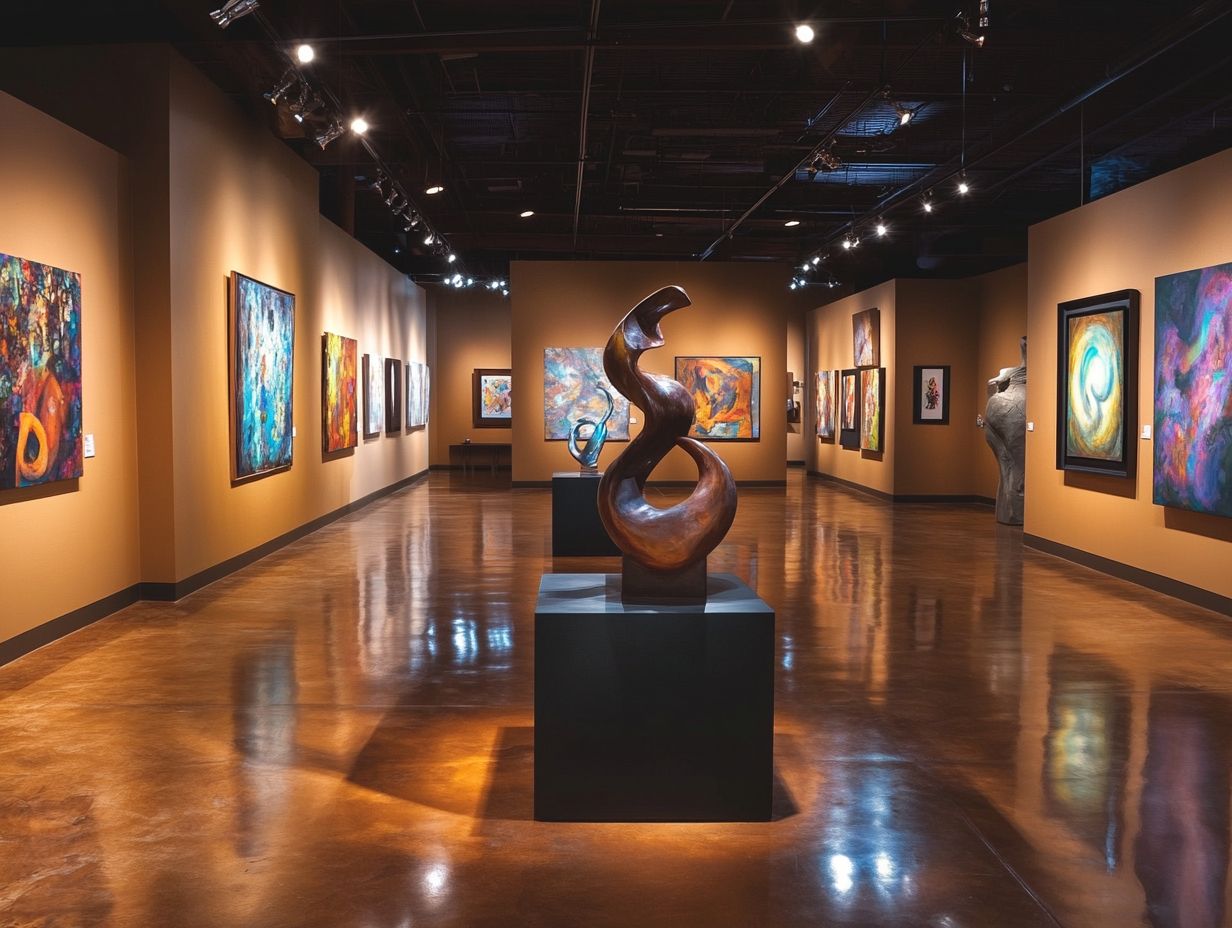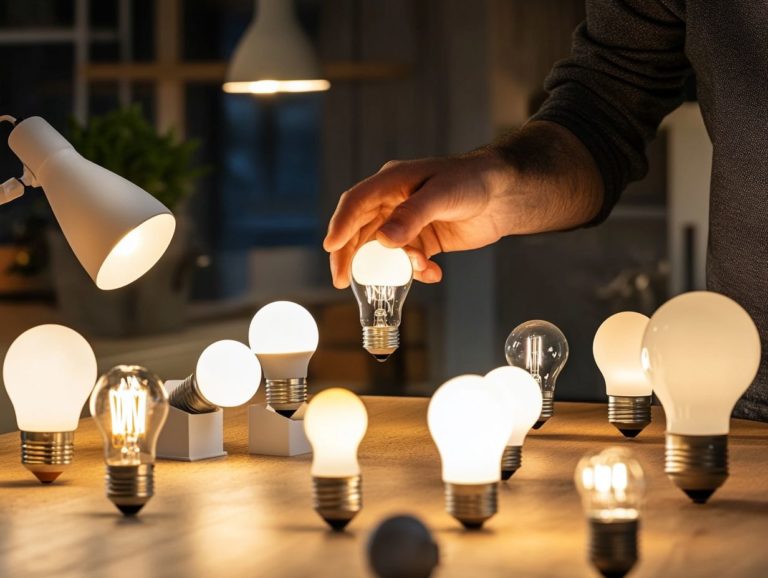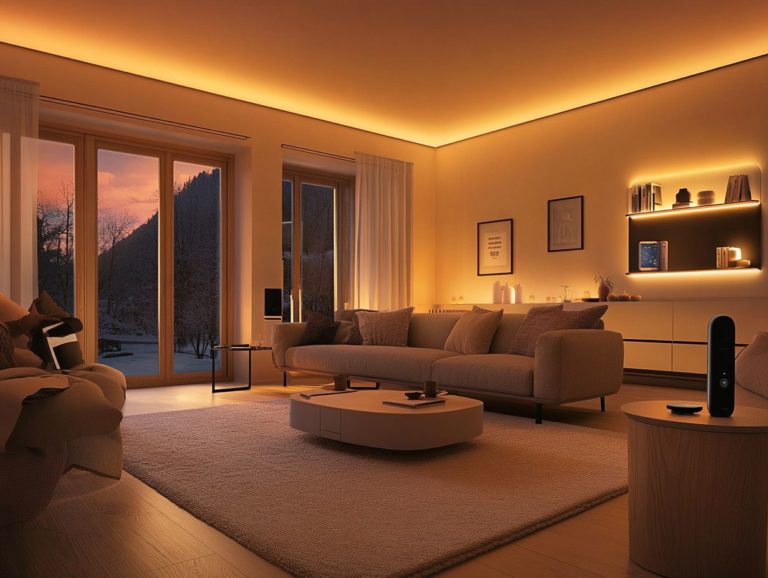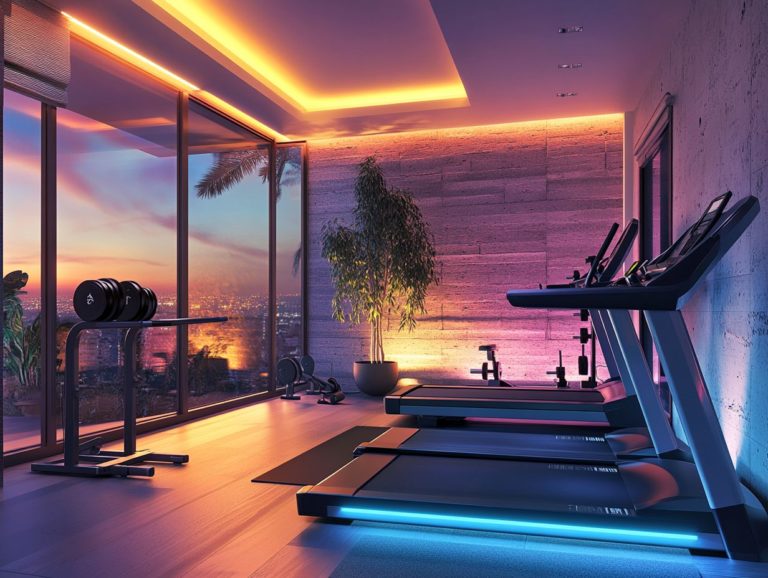“Best Lighting Solutions for Art Displays”
Lighting is essential in both the presentation and preservation of art, significantly influencing how you perceive and appreciate each piece.
Choosing the right lighting whether it s natural light or cutting-edge LED options can enhance the artwork’s colors and textures while protecting it from potential damage.
In this article, you ll discover various types of lighting, key factors to consider, and practical tips for creating the ideal ambiance for any display.
Whether you re a gallery owner, artist, or passionate art enthusiast, understanding these elements can truly elevate your exhibitions.
Contents
Key Takeaways:

- Proper lighting is crucial for art displays as it enhances quality and preserves artwork.
- Natural and LED lighting are the most suitable options, providing optimal illumination without causing damage.
- When choosing lighting, consider the type of artwork, display space, layout, budget, and energy efficiency.
Understanding the Importance of Lighting in Art Displays
Lighting in art displays is very important, significantly influencing how you perceive each artwork. It impacts not only the visual presentation but also the preservation of beautiful art pieces in your home gallery.
Thoughtful lighting enhances colors and textures, skillfully managing light sources to craft the ideal ambiance. This invites art enthusiasts to explore the details and emotions captured in each piece.
By employing various lighting techniques and fixtures, you can dramatically elevate the viewing experience, transforming an ordinary display into a captivating showcase of creativity.
Impact on Display Quality and Preservation
The impact of lighting on the quality and preservation of artwork is significant; improper illumination can lead to fading, discoloration, and degradation over time.
As a collector or curator, you should know that different types of lighting like incandescent, fluorescent, or LED emit varying levels of UV light, which can affect the longevity of delicate pieces. For example, fluorescent lights generate higher levels of UV exposure, posing a risk to sensitive materials, while modern LED solutions provide customizable light options that minimize both heat and UV output, enhancing preservation.
Finding the right balance in light intensity is crucial; too much brightness can overwhelm an artwork s surface, while insufficient lighting can inhibit visibility and appreciation. Ultimately, an expertly planned lighting strategy not only showcases artwork beautifully but also extends its lifespan, ensuring enjoyment for generations to come.
Types of Lighting for Art Displays
In the realm of art displays, the right lighting can elevate visual allure and overall experience, making your choice vital as both an artist and a collector. Whether you opt for the precision of LED lights or the warmth of natural light, each option offers its own set of benefits for showcasing your artwork.
Imagine the striking effect of focused beams from track lighting or the gentle radiance of wall-mounted fixtures. By mastering the use of picture lights and recessed lighting, you can create the ideal ambiance for your home gallery, ensuring your art is presented in the best possible light.
Natural Lighting
Natural lighting presents a remarkable and ever-evolving way to illuminate your artwork, creating an ambiance that shifts throughout the day while enhancing colors and textures with its warm glow.
When you incorporate natural light, you foster a deeper connection between the viewer and the art, emphasizing the organic qualities of the materials at play. However, prolonged exposure to sunlight can cause colors to fade and deteriorate, making effective light management crucial.
To maximize the benefits of natural light, consider positioning your art displays strategically near windows equipped with adjustable shades or filtering systems. This allows you to find a delicate balance between showcasing the artwork’s vibrancy and safeguarding it from damage.
Ready to transform your art display? Let s get started on creating your perfect lighting setup!
Track Lighting

Track lighting serves as a versatile and effective solution for illuminating your artwork. It offers adjustable angles and focused beams that highlight specific details and create layers of visual depth.
This adaptability makes it perfect for various art forms. Whether you’re showcasing vibrant paintings or intricate sculptures, configuring the tracks to align with your artwork s dimensions can draw attention to particular features. You can cultivate an immersive experience.
Energy-efficient LED options lower your electricity costs and contribute to a more sustainable environment. Layered lighting evokes moods, enhances textures, and sets the stage for storytelling, allowing each piece to resonate more profoundly with viewers.
Recessed Lighting
Recessed lighting offers a sleek and modern approach to illuminate your artwork. It enhances the depth and texture of the pieces while maintaining a clean aesthetic that won’t overwhelm your space.
This innovative lighting technique is designed to be unobtrusive, allowing the art to take center stage rather than the fixtures themselves. By strategically placing these lights in your ceilings or walls, you can create an elegant atmosphere that seamlessly blends with your room’s design.
Pay attention to spacing and alignment to avoid harsh shadows. This ensures an even distribution of light throughout the area.
Incorporating dimmers can elevate your experience. Dimmers allow you to adjust light intensity, creating the perfect mood for any occasion.
LED Lighting
LED lighting has swiftly become the go-to choice for art displays, thanks to its energy efficiency and versatility. LED lights offer a spectrum of color temperatures that perfectly showcase a variety of artworks.
The advantages extend beyond aesthetics: these lights boast impressive longevity, meaning you won t have to replace them frequently. Their low heat output is particularly advantageous for art preservation, as excessive heat can damage delicate materials like canvas and paper.
When considering light quality, LED lights truly shine in their ability to represent colors accurately. This ensures that each piece of art is displayed in its truest form, making them an exceptional choice for galleries and collectors. You ll enhance the overall viewing experience while protecting your valuable works.
Factors to Consider When Choosing Lighting for Art Displays
Selecting the perfect lighting for your art displays requires careful consideration of several key factors. Think about the type and medium of the artwork, the characteristics of your display space, and your budget constraints.
Each element plays a crucial role in ensuring that the lighting solution enhances the artwork, allowing it to shine in all its glory.
Artwork Type and Medium
The type and medium of artwork significantly influence your lighting decisions. Various materials and styles demand specific illumination techniques to enhance their visual appeal.
Your paintings may shine under soft, diffused lighting that highlights brush strokes and colors without glare. This allows viewers to fully appreciate the intricate details. In contrast, sculptures thrive under directional lighting, which casts dramatic shadows and accentuates textures, bringing every curve and angle to life.
For photographs, controlled lighting is key; it enhances contrasts while preserving depth of field, offering a dynamic perspective that draws the audience into the moment you’ve captured.
By thoughtfully selecting lighting solutions tailored to each artwork’s unique characteristics, you can elevate the overall experience and draw attention to the craftsmanship and emotion in each piece.
Display Space and Layout

The display space and layout play a crucial role in how you arrange lighting to create the desired atmosphere while showcasing your artwork.
Several factors influence your lighting choices: wall color, room size, and furniture arrangement. Lighter wall colors amplify natural light, giving an airy feel, while darker tones absorb light, requiring brighter sources. In larger rooms, multiple light sources may be necessary to eliminate shadows. Smaller areas benefit from focused lighting to create intimacy.
To achieve balance, add dimmers and adjustable fixtures. This flexibility allows you to highlight specific pieces while keeping the overall display engaging and well-composed.
Budget and Energy Efficiency
When selecting lighting for your art displays, consider both budget and energy efficiency. These factors impact your short-term costs and long-term expenses significantly.
Finding the right balance between optimal brightness and financial limits is essential. Often, the best solution involves choosing energy-efficient options that enhance visual appeal while fitting your budget.
Techniques such as using LED lighting provide exceptional brightness with lower power consumption. Adding dimmable fixtures increases versatility, allowing adjustments based on time of day or specific exhibitions. These strategies ensure your artwork shines brilliantly without sacrificing financial prudence.
Tips for Properly Lighting Art Displays
To achieve an impeccable lighting setup for your art displays, consider key factors: strategic placement and angle of the lights, selecting the optimal color temperature, and adding control options such as dimming.
These elements create the ideal atmosphere that enhances the beauty of your artwork.
Placement and Angle of Lights
The placement and angle of lights are essential for achieving perfect illumination. They govern how shadows, highlights, and overall visibility are managed.
Positioning your lights correctly enhances the depth and texture of your pieces, inviting viewers in. In a gallery setting, using track lighting at a 30-degree angle brings three-dimensional qualities of sculptures to life, revealing intricate details.
In a cozy home environment, softer, diffused lighting can create warmth and intimacy, effectively highlighting textures and colors on a painted canvas. Understanding and applying these foundational techniques transforms any space into a captivating visual narrative.
Color Temperature and CRI
Knowing about color temperature and the Color Rendering Index (CRI) is essential when choosing the right lighting for artwork. These elements significantly influence how colors are perceived in a display.
When considering various types of artwork paintings, photographs, or sculptures the relationship between lighting and color can enhance or distort the viewer’s experience. Color temperature, measured in Kelvin, refers to the light source’s warmth or coolness, dramatically altering the mood conveyed by the piece. Cooler light may accentuate crisp details in modern photographs, while warmer light creates a cozy, inviting atmosphere for traditional paintings.
A high CRI rating ideally above 90 ensures colors appear true to life, accurately reflecting their intended hues. To achieve the best results, consider both the artwork type and desired ambiance when selecting lighting. This careful attention to detail elevates the impact of each piece.
Dimming and Control Options

Dimming and control options for lighting are essential in crafting a versatile ambiance for your art displays, enabling you to make adjustments that harmonize with both the viewer s experience and the essence of the artwork.
These options enhance the visual appeal of the pieces. They also preserve the integrity of the artwork.
For instance, adjustable LED systems can emit softer light for delicate paintings or brighter illumination for sculptures. This creates a beautiful display.
The convenience of remote control features allows effortless brightness adjustments, facilitating smooth transitions between different exhibits. Smart lighting systems elevate this experience further, offering programmed settings that can mimic natural light conditions, enriching the overall atmosphere, and ensuring that your art is showcased in its best light.
Frequently Asked Questions
What are the best lighting solutions for art displays?
The best lighting solutions for art displays depend on the specific artwork and its environment. Some popular options include track lighting, recessed lighting, and LED lights.
Can natural light be used for art displays?
Yes, natural light can be used for art displays, but it may not be the best option as it can be unpredictable and may cause damage to certain types of artwork.
What is the importance of proper lighting for art displays?
Proper lighting transforms art displays into stunning experiences. It enhances the appearance of the artwork, creates a focal point, and allows viewers to see the details and colors of the piece.
Are LED lights a good choice for art displays?
Yes, LED lights are a popular choice for art displays as they produce minimal heat and UV radiation, making them safe for delicate artwork. They also have a long lifespan and are energy efficient.
How can I determine the best lighting solution for my art display?
Discovering the best lighting solution for your art display is exciting! Consider factors like the size and type of artwork, the desired ambiance, and the location of the display. It is also helpful to consult with a professional lighting designer.
Is it necessary to hire a professional for lighting an art display?
While it is not necessary to hire a professional, it is recommended to do so for optimal results. A professional lighting designer can assess your artwork and space and create a customized lighting plan to showcase your art in the best possible way.






